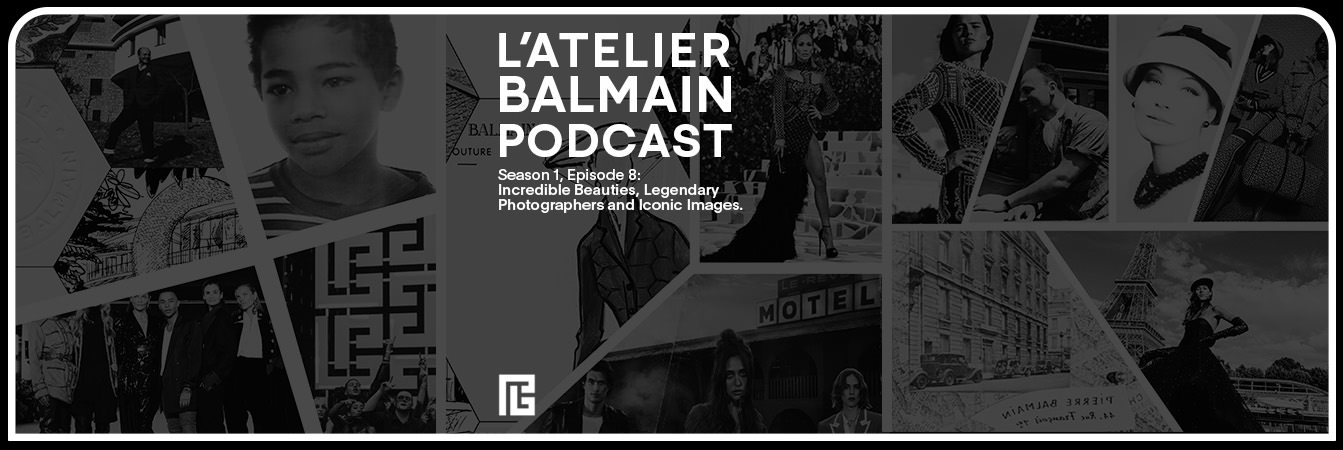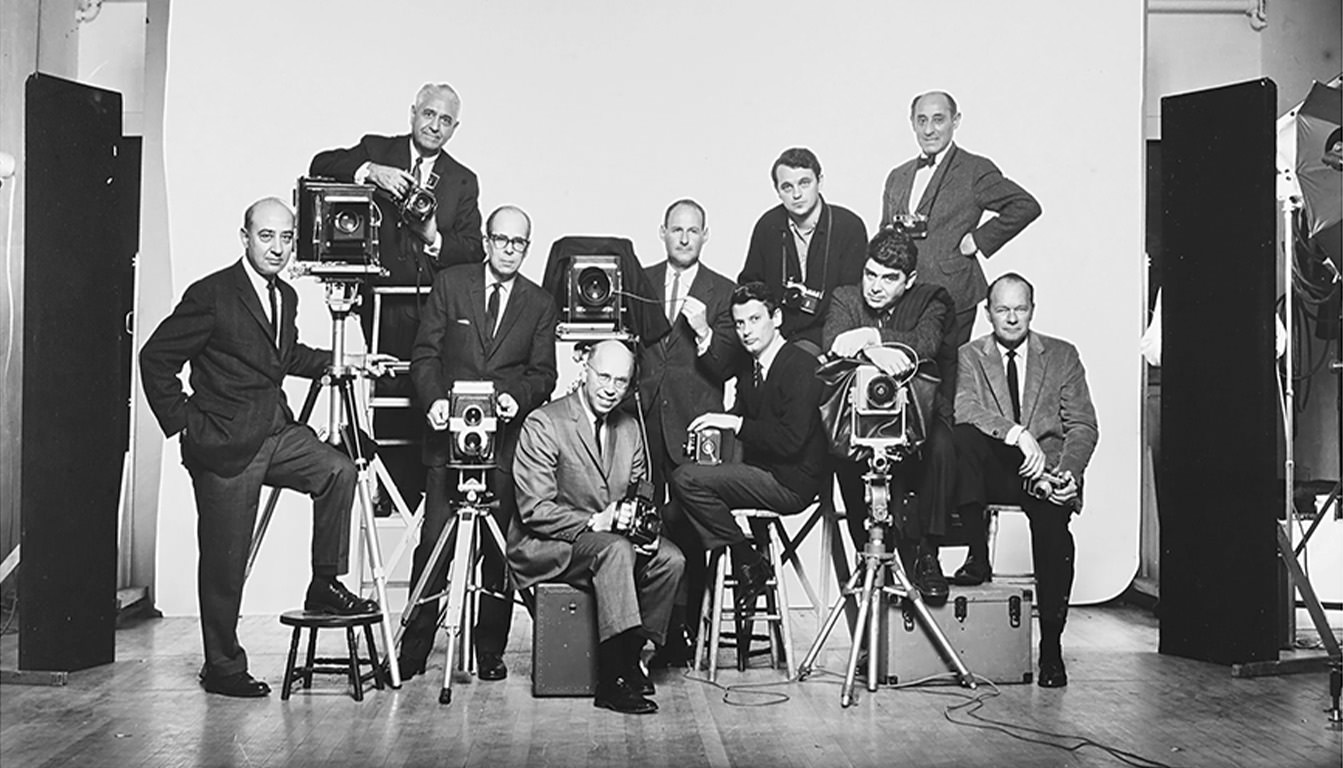INCREDIBLE BEAUTIES, LEGENDARY PHOTOGRAPHERS, AND ICONIC IMAGES
SEASON 1, EPISODE 8 :

BALMAIN'S ICONIC MID-CENTURY IMAGES
Pierre Balmain’s designs were key ingredients in some of the twentieth century’s most important fashion shootings. Month after month, season after season, decade after decade, the house’s couture creations were worn by beautiful models in incredible locations, captured by talented photographers and published by the leading magazines.
For this episode, we’ll be turning to two fashion authorities, who will help to bring us up to speed about some of those world-renowned photographers, models and images.
One of those experts is Susanna Brown, who joins the Balmain podcast for a second time. Brown, a photography curator and art historian, has overseen some of the most impressive photography exhibitions in recent years, including a 2012 exhibit on Cecil Beaton, a 2014 exhibit on Horst and the acclaimed 2019 show on Tim Walker—all first shown at London’s Victoria And Albert (V&A) Museum. A few episodes ago, Susanna Brown spoke with us about the photographer Horst and she returns today to talk about other legendary fashion photographers of the twentieth century and walks us through some of their most notable creations.
Lynn Yaeger, the CFDA-award winning journalist who is known for her unique ability to mix an incredible design knowledge with often-amusing and always thought-provoking takes on class, politics, society and history also joins us on this episode.
As Susanna and Lynn move through the photographers, models and images of this episode, you may want to click on the many links we have included below, in order to see the iconic images that they are describing.

GORDON PARKS + BETTINA
As Susanna Brown explains, Parks was a very influential photojournalist, as well as someone with a great eye for an elegant fashion study. Throughout his long career, Park continued to use his camera to explore racism, poverty and American urban life, while also shooting glamorous Parisian and American fashion.
Gordon Parks’ famous 1951 studio shooting of Bettina in Balmain reflected two facts: Parks preferred images of relaxed models in natural poses that appeared that he was catching them off guard and Parks and Bettina were old friends that liked working together. The easy spirit of the shooting is reflected in the many beautiful out-takes that now can be found exhibited around the globe, in museum and private collections.
HENRY CLARKE + BETTINA + NENA VON SCHLEBRUGGE
The American photographer Henry Clarke managed to negotiate a unique contract with Vogue. From 1951 onwards, he photographed for the French, British and American versions of the powerful fashion publication. He covered the spring and summer couture collections for the magazine more frequently than any other photographer. Just like Gordon Parks, Clarke also shot some beautiful images of the famous French model Bettina in Balmain. Susanna Brown and Lynn Yaeger both describe an iconic image of Bettina and daffodils, which Clarke shot for Vogue in 1950.
Among Clark’s other iconic images highlighted by Susanna Brown in this episode are two shots of the model Anne Saint Marie wearing Balmain on the Paris streets, a color photo of a model in Balmain posed leaning against a bright yellow vintage luxury car and an image from 1959 of the model Nena von Shlebrugge in a Balmain coat.
NORMAN PARKINSON + NENA VON SCHLEBRUGGE + WENDA PARKINSON
As Susanna Brown notes, unlike many of his predecessors, the famed English photographer Norman Parkinson preferred not to direct his subjects. Instead, he wanted them to be as spontaneous as possible for his camera. And this approach injected a great sense of fun into many of his Images. Parkinson is well known for the many beautiful images he created in collaboration with his wife, the model Wenda Parkinson. Among the other famous models that he worked with is Nena von Shlebrugge, whom Parkinson famously “discovered” in 1955, while on a trip to Stockholm. Parkinson’s test shots of the young von Shlebrugge make clear her beauty and also highlight the resemblance of the famous model to her even-more-famous famous daughter, Uma Thurman. Nena von Shlebrugge would collaborate with Parkinson on many legendary fashion shootings, including those that resulted from the trip to France’s Champagne region, which Susanna Brown discusses in the podcast.
IRVING PENN + LISA FONSSAGRIVES
Just like Norman and Wenda Parkinson, Irving Penn and his wife, the famous Swedish model Lisa Fonssagrives formed a very dynamic fashion duo. Fonssagrives, as Lynn Yaeger points out was perhaps the first real supermodel. She was a consummate professional and created several iconic fashion images in partnership with the mid-century’s greatest photographers. In episode six of the Balmain podcast, when Susanna Brown introduced us to the fascinating history of the photographer Horst, she highlighted one of Fonssagrives’ most famous Vogue shootings, which Horst shot in 1953. Penn first met Fonssagrives in 1947, when he photographed her for Vogue with 11 other top models, all dressed in American designs.
LOUISE DAHL-WOLFE + MARY JANE RUSSEL
As Susanna Brown points out, there were numerous other photographers who formed strong collaborations with models—even if the duo wasn’t married. The great American photographer Louise Dahl-Wolf, for example, worked very closely with the model Mary Jane Russell for more than a decade, creating dozens of famous images. Dahl-Wolfe was not a fan of what she called the “candy-box” look of the popular models of her time—which she described as "all translucent white skin, blond hair and blue eyes.” She preferred distinctive beauties like the Russell and the young model Betty Joan Perske—a.k.a. Lauren Bacall—whom Dahl-Wolfe shot for an iconic Harper’s Bazaar cover in 1942.
WILLIAM KLEIN + DOROTHY MCGOWAN
William Klein, as Susanna Brown makes clear, loved breaking the rules of fashion photography, playing with blurry pictures, camera flash, grainy images and the distortions caused by wide-angle and telephoto lens. His favorite collaborator was the American model Dorothy McGowan. McGowan, as Lynn Yaeger points out, had an exuberance and bold spirit that set her apart from the famously austere models of the time. She was always up for an adventure and new ideas—which helps explain why so many of the greats loved working with her
MELVIN SOKOLSKY + DOROTHY MCGOWAN
Melvin Sokolsky was a self-taught photographer who joined Harper's Bazaar in 1958. He went on to create some of the most famous images in modern fashion photography, the so-called bubble series of March 1963. This extraordinary series was initially inspired by the transparent orbs in Hieronymus Bosch’s famous painting, The Garden of Earthly Delights. Two years later, he made a model fly again. This time it was Klein's favorite model, Dorothy McGowan. In his famous shooting, we see McGowan gliding through a chic French restaurant. Adding to the extraordinary feel of the image, Susanna Brown, is the fact that the diners below simply continue their meal, apparently completely oblivious to what's happening directly over their heads.
RICHARD AVEDON + DOVIMA + SUZY PARKER, ETC
Lynn Yaeger: “Richard Avedon’s great talent, distinctive empathy, and unusually collaborative attitude allowed him to play a key part in the discovery and promotion of several generations of supermodels: beginning with Dovima, Dorian Leigh and Suzy Parker in the ‘50s, through Veruschka, Lauren Hutton and Anjelica Huston in the ‘60s and ‘70s, and, then in the ‘80s, with those famous Avedon images of Brooke Shields. Well, actually Avedon kept at it all the way up to the ‘90s, with his amazing images of Stephanie Seymour.”
That unusual history of “discovering” many of the greatest models of the twentieth century was the basis for the plot of the 1956 light-hearted film “Funny Face.” The Avedon role is played by Fred Astaire and the model that he discovers, played by Audrey Hepburn, channels the feisty spirit of the model Suzy Parker, who was one of Avedon’s most famous muses.
SAVID BAILEY + JEAN SHRIMPTON
David Bailey landed a position at British Vogue at age 20—and it’s safe to say that until he arrived, British Vogue had never seen a young and wild talent like him. Bailey pushed for changes —perhaps the most notable being that he forced the very aristocratic editor at the time to let him photograph the beautiful farmer’s daughter that he discovered —Jean Shrimpton. Bailey’s and Shrimpton’s collaborations were both witty and gritty. They famously flew to New York in 1962, where Bailey shot her in distinctly non-glam, non-posed street scenes—during a winter that was so bitterly cold, that the camera kept sticking to Bailey's fingers. Even today, those black-and-white images remain incredible, with those shots still often cited as inspirations by leading fashion designers.
Photo Credits :
Photographers from the Famous Photographers School in Westport posed for a self-portrait in 1964. They are from left: Arthur D’Arazien, Joseph Costa, Phillipe Halsman, Harry Garfield, Irving Penn, Richard Avedon, Bert Stern, Ezra Stroller, Alfred Eisenstaedt and Richard Beattie.- Copyright Free. Source: Wikipedia Commons and https://pleasurephotoroom.wordpress.com/tag/arthur-darazien/
Credits :
Balmain Creative Director: Olivier Rousteing- Special Podcast Guests: Susanna Brown and Lynn Yaeger
- Episode Direction and Production: Seb Lascoux
- Balmain Historian: Julia Guillon
- Episode Coordination: Alya Nazaraly
- Research Assistance: Pénélope André and Yasmine Ban Abdallah
- Digital Coordination/Graphic Identity: Jeremy Mace
- Episode researched, written and presented by John Gilligan
To explore further :
Pierre Balmain: My Years and Seasons, (Doubleday, 1965)- See acast.com/privacy for privacy and opt-out information.